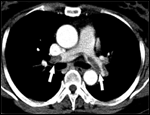Analysis of Clinical Trials Show No Added Risk of VTE Among Patients On Chemo + Bevacizumab
The Journal of Clinical Oncology published a paper ahead of print on March 21, 2011 that shows no increased risk of venous thromboembolisms (VTEs) when bevacizumab was added to chemotherapy compared to chemotherapy alone.
The Journal of Clinical Oncology published a paper ahead of print on March 21, 2011 that shows no increased risk of venous thromboembolisms (VTEs) when bevacizumab was added to chemotherapy, compared to chemotherapy alone (DOI: 10.1200/JCO.2010.32.3220). The retrospective study compiled data from 6,055 patients from ten randomized Phase 2 and 3 trials and assessed risk of VTEs for all patients and by tumor type.

Chest Spiral CT showing multiples filling defects of principal branches, due to acute and chronic pulmonary embolism. Source: Walter Serra, Giuseppe De Iaco, Claudio Reverberi, and Tiziano Gherli , Wikimedia Commons
There were no statistically significant increases in the incidences of VTEs for bevacizumab versus controls in the overall population or by tumor type. The unadjusted incidence of VTEs in the entire study population was 10.9% in the bevacizumab group compared to 9.8% for the control group.
The Link Between VTE and Cancer
The association between VTE and cancer has been recognized for over 100 years. VTE significantly affects the morbidity and mortality of cancer patients, yet it still goes highly under-diagnosed and under-treated. VTE and cancer are closely linked because of the mechanisms of tumor angiogenesis and invasion: Cancer can alter the circulatory dynamics in the body, resulting in alterations in clotting factors, platelet function, and systemic inflammation. The risk of VTE is influenced by cancer type and burden, and exposure to chemotherapy and hormone therapy can both hasten VTE.
Currently, the American Society of Clinical Oncology guidelines for VTE include anticoagulant prophylaxis for all hospitalized cancer patients and low molecular weight heparin as the preferred agent for initial and continuing treatment for VTE.
Bevacizumab was associated with an increased risk of VTE in a 2008 study (Nalluri et al. JAMA 300: 2277, 2008). However, as the authors of the current paper point out, “that report had several limitations and is in conflict with another analysis that found no increased risk of VTE in patients treated with bevacizumab.” The older study used summary statistics rather than individual patient data. Therefore, the current study, the largest analysis performed to date, aimed to address the controversy of VTE occurrence with bevacizumab.
The Study Design
Although this is a retrospective meta-analysis study, the data used is gold-standard type patient-specific data and not aggregate data. The ten controlled and randomized trials chosen compared bevacizumab plus chemotherapy to chemotherapy alone. The patient population included those with metastatic colorectal cancer, metastatic breast cancer, non–small-cell lung cancer, renal cell cancer, and pancreatic cancer. Importantly, all VTE events were analyzed up to 21 days after the last study dose in order to minimize bias from different study protocols, including control crossover, second-line treatment, and variable post-protocol treatments.
The Study Results
The rates of VTEs were similar in control vs bevacizumab-treated groups in patients with non–small-cell lung cancer, renal cell cancer, metastatic colorectal cancer, and metastatic breast cancer. In pancreatic cancer patients, the rate was lower (35%) in the bevacizumab group compared to the control (53%). No difference in VTE incidence was seen when lower or higher bevacizumab doses were compared. Likewise, there was no difference in the time to onset for a VTE between control and bevacizumab groups, or in severity of VTE.
The study identified risk factors for VTEs: tumor type, older age, poorer performance status, history of VTE, and baseline oral anticoagulant use. However, no interaction between these factors and bevacizumab was found for the patient population analyzed.
Bleeding Patterns with Bevacizumab
This study showed that the risk of grade 3 to 5 bleeding was low and unaffected by bevacizumab treatment, which was consistent with previously reported data. Thus far, all analyses have shown that anticoagulation therapy concurrent with chemotherapy is safe and risk of serious bleeding does not increase when bevacizumab is added to the protocol.
Risk of grade 1 or 2 bleeding, primarily epistaxis, was slightly increased in the bevacizumab group (1.9% vs 1.2%) consistent with the Bevacizumab Expanded Access Trial (BEAT) observational study presented at an ASCO meeting in 2010.
The study limitations include retrospective analysis, differences among the pooled clinical trials, and differing tumor type of patients. This analysis was not able to assess the VTE risk of bevacizumab monotherapy, which is an important concept that needs investigation. This study underscores the significant frequency of VTE in cancer patients, as well as the need for more awareness and better management of this cancer complication.
Targeted Therapy First Strategy Reduces Need for Chemotherapy in Newly Diagnosed LBCL
December 7th 2025Lenalidomide, tafasitamab, rituximab, and acalabrutinib alone may allow 57% of patients with newly diagnosed LBCL to receive less than the standard number of chemotherapy cycles without compromising curative potential.